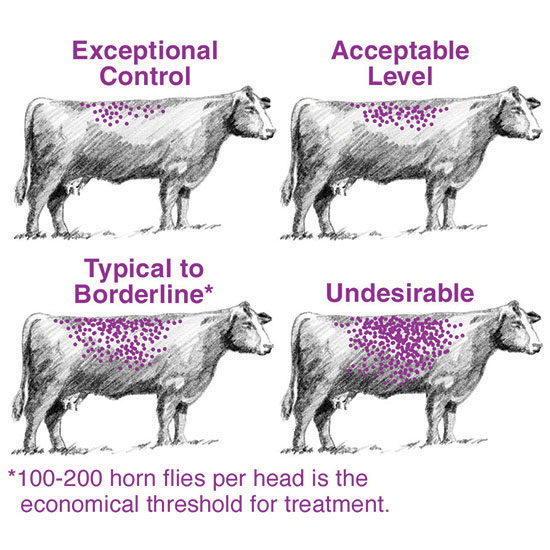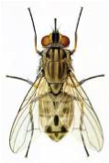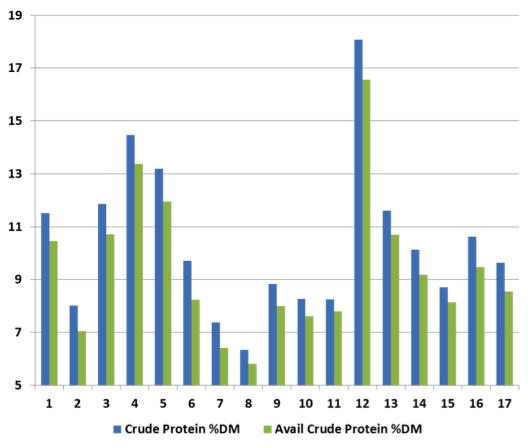Vitamin D is often known as the “sunshine vitamin” because it is synthesized in response to exposure to sunlight. There are two major natural sources of vitamin D, cholecalciferol (vitamin D3) and ergocalciferol (vitamin D2). Vitamin D3 is synthesized in the skin of many herbivores and omnivores upon exposure to UV light from sunlight. Vitamin D2 is not found in green forages, but is formed when the dying leaves are exposed to sunlight. Thus, sun cured hay is a good dietary source of vitamin D2. Livestock utilize vitamin D3 much more efficiently than vitamin D2.
Fly control and profitability
Parasites are a drain on cattle performance and your wallet. While most people may not include flies in the parasite category, they should. Horn flies, in particular, are the most economically important external parasite in cattle production with estimated losses averaging $1 billion annually. Prevention and control are the keys to tipping the scale back in your favor.
Copper linked to fescue toxicity
Fescue toxicity is the most costly grass-related disease in the United States with production losses exceeding $600 million per year. An endophyte fungus within the fescue plant causes fescue toxicosis. This endophyte produces alkaloids that cause adverse symptoms in grazing livestock including: decreased weight gain or even weight loss, reduced milk production, higher body temperature, increased respiration rates, rough hair coat, unthrifty appearance, loss of blood flow to extremities, excessive salivation and poor reproduction.
Five ways to maximize beef cattle returns from forages during the summer and fall
We would like to continue with our theme of maximizing profitability from forages as we head into the summer and fall. The importance of making the most from your forage base is a key factor in reducing additional expenses as well as optimizing calf performance and cow reproduction. Summer and Fall grazing conditions bring upon new opportunities for capturing added value from your forages. I have outlined a few of those opportunities below that can pay dividends for most beef producers. We will also expand on these areas over the next 5 weeks to help provide you more information to determine if they have the potential to help you with your bottom line.
Rotational grazing systems for extending grazing capacity
Rotational grazing is one of the best ways to maximize forage utilization by managing stocking rate and pasture size. The reality is pasture ground is hard to find and quite valuable. In some area, I see planters working fields that had been pasture for the last 50 years. With rotational grazing the concept is to divide the grazing area into paddocks that a group of animals can consume within 7 to 10 days.
Forage preservatives can dramatically reduce dry matter loss in silage and hay
Your largest feed expense is stored forage. Your hay and silage is worth more than ever before. Efforts to improve your management of forage storage will result in a good return on your investment.
Annual crops can provide additional grazing or stored forages when needed
Utilizing Annual crops as feedstuffs for livestock is a common practice, and in today’s environment of higher forage and pasture costs, it really makes sense. Many and maybe most livestock production systems today involve some sort of farming aspect to the operation. Yes, producing hay is considered farming in some circles but that’s not the point of this blog. In sustainable ranching practices, having the forage resource available and not having to purchase significant amounts of additional forages or supplements is a key indicator of profitability.
All a buzz about an early spring
We have come through a very mild winter and are off to an early spring with record setting high temperatures. A negative affect is an early emergence of flies. This will be a year where an integrated fly control program will be needed for effective fly control. The tools for fly control include sanitation, feed through products, sprays, dust, rubs, fly tags and various fly traps. Determine which fly is the problem because control measures will vary by species. The early warm temperatures may allow the fly population to get an earlier than normal start. Below is a description of the common flies that impact cattle performance.
After a drought: Parasites abound!
Congratulations! You made it through one of the worst droughts on record. Now that the rains have come and the grass is green again, your worries are over, right? Wrong! Now your livestock are picking up all of the parasites that lay dormant all of those months of drought. Are you ready?
Hay allocation and manure scoring: Meeting the nutritional demands of the beef cow
Hay quality will vary due to forage type, stage of maturity at harvest and harvest conditions. In addition to hay, feeding harvested crop residue such as corn stalk bales is common. Often a combination of different quality hays are fed at the same time using past experience and some nutritional “cow sense” helping to determine the correct blend. Cow body condition and cow contentment are used as rough indicators of meeting the dry matter intake and energy needs of the cows. Evaluating the manure is a tool that can help indicate when changes in the forage mix or supplement strategy is needed. We need to be aware that the nutritional needs of the cow will change depending on production cycle.



